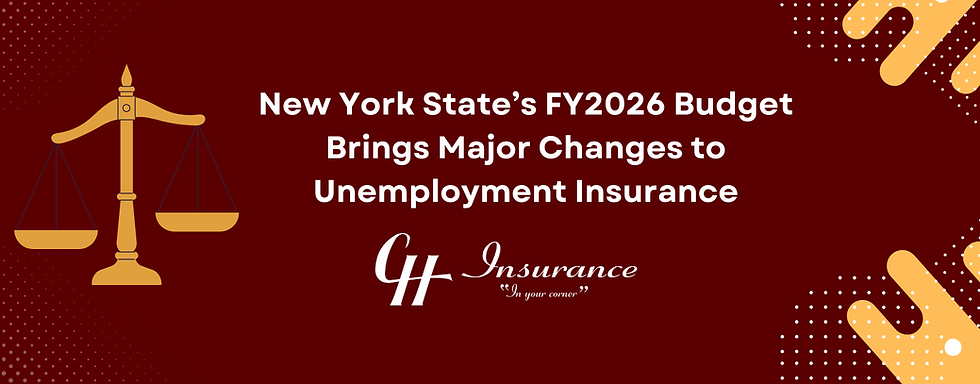New York State’s FY2026 Budget Brings Major Changes to Unemployment Insurance
- dgraham43
- Aug 27, 2025
- 4 min read

New York State’s FY2026 budget includes a sweeping overhaul of the Unemployment Insurance (UI) system. The changes provide immediate cost relief for employers while also laying the groundwork for long-term structural reforms.
Unemployment Insurance 101
Despite the name, unemployment insurance is not insurance in the traditional sense. It is not a policy that an employer can purchase on the market. Instead, it is a state tax that funds a state-run benefit program and applies to almost every employer in the state with very few exceptions, such as clergy. The system is designed to provide short-term financial support to workers who lose their jobs through no fault of their own, such as layoffs or workforce reductions. It is not intended to cover individuals who voluntarily quit their jobs or are terminated for cause.
Each employer’s UI tax rate is set by the state and determined largely by their history of unemployment claims. Employers with fewer claims are rewarded with lower rates, while those with more frequent or costly claims face higher rates. Longevity also plays a role: a brand new business is assigned a standard “new employer” rate until it has enough claims history for the state to calculate an individualized rate. That rate can then go up or down each year based on claims activity.
Employers pay UI tax on a set amount of employee wages known as the taxable wage base. The taxable wage base is the maximum amount of each employee’s wages subject to UI tax in a given year, and it is adjusted periodically by the state. In 2025 the taxable wage base is $12,800.
What all of this adds up to is that unemployment is a controllable business expense. By carefully managing terminations, responding promptly to claims, and keeping accurate records, employers can help keep their tax rate and overall UI costs lower over time.
Short-Term Relief
To eliminate the pandemic-era debt owed to the federal government, Governor Hochul and state lawmakers are allocating $8 billion from state reserves to pay off the UI Trust Fund’s balance. This provides relief in two important ways:
The Interest Assessment Surcharge (IAS) will be eliminated. The IAS was a special annual surcharge added to employer bills to cover the interest New York owed on federal loans taken to keep the UI Trust Fund solvent during the pandemic.
As the Trust Fund regains solvency, UI tax rates for employers are expected to decline.
This represents welcome news for businesses that have faced elevated unemployment costs since 2021. However, actual savings will still depend on each employer’s unique UI rate, which is tied to claims history and other factors.
What’s Changing and When
October 2025: The maximum weekly UI benefit increases from $504 to $869, the first increase since 2019.
January 1, 2026: The taxable wage base rises slightly from $12,800 to $13,000.
January 1, 2027 and beyond: The taxable wage base will adjust automatically to 16% of the New York State Average Annual Wage, rounded to the nearest $100. Based on prior wage growth, employers should expect a substantial jump from 2026 to 2027, with smaller annual increases thereafter.
The new indexing system is intended to strengthen the Trust Fund over time, but it also means UI taxes will apply to a steadily growing portion of wages.
Long-Term Considerations
While the 2026 budget delivers near-term savings, the longer-term picture is more complex:
As the taxable wage base increases annually, even lower tax rates may apply to a broader share of wages, raising total costs per employee.
The increase in maximum benefit amounts will result in larger payouts from the system. Over time, this can influence experience ratings and potentially push employer rates higher, especially for those with frequent claims.
In other words, the reforms aim to create a more solvent and stable UI system, but the cost burden will gradually shift back to employers.
Practical Steps for Employers
Businesses should prepare now for both the short-term relief and the longer-term increases in the taxable wage base and benefit payouts. Proactive measures include:
Submitting quarterly payments on time to avoid penalties.
Reviewing notices of benefit entitlement and charges for accuracy.
Exploring alternatives to layoffs, such as reduced hours or shared work programs.
Protesting charges when appropriate. Strong documentation is essential.
Monitoring for fraudulent claims.
Consider outplacement programs- the less time someone is out of work the less they will in benefits, which impacts the employer’s rate.
Considering professional support for claims management.
Conclusion
The FY2026 budget marks a turning point for New York’s UI system. Employers will see short-term relief as debt is retired and the IAS is eliminated, but should also anticipate higher taxable wage bases and benefit levels in the years ahead. Employers that actively manage their claims and plan for future liability will be best positioned to adapt as the system evolves. Want to learn more about unemployment as a controllable business expense? Contact the CH Insurance HR contact Danielle Roche at droche@chinsurance.cc and schedule a time to review your current UI tax rate and steps you can take to control it.









О que mais me chama atenção no Portal Cardmates é a consistência do conteúdo ao longo dos anos. Dá para perceber que não é algo feito às pressas, mas sim baseado em testes reais e experiência prática desde 2012. Para quem busca entender melhor o mercado e tomar decisões mais conscientes, esse tipo de abordagem faz diferença.
No meio de tantas informações espalhadas pela internet, é útil ter um ponto de referência confiável, com análises claras e explicações acessíveis. Inclusive, ao pesquisar sobre métodos de pagamento e soluções modernas, acabei encontrando este material https://cardmates.com.br/cassinos-online/pix pix cassino, que ajuda bastante a entender como funcionam essas opções hoje em dia.
No geral, o portal cumpre bem a proposta de ser um espaço informativo…